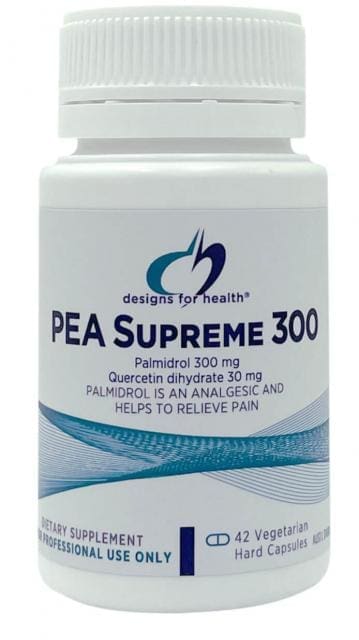Introduction
Chronic pain is a major source of morbidity for millions of people worldwide. It can have a significant impact on quality of life, affecting sleep, mood, and overall function. While there are a number of medications available for the treatment of chronic pain, many of them have side effects that can be unpleasant or even dangerous.
In recent years, there has been growing interest in the use of natural compounds for the treatment of chronic pain. One such compound is Palmitoylethanolamide (PEA), a naturally occurring fatty acid amide that has been shown to have anti-inflammatory and analgesic effects.
What is PEA?
PEA is a naturally occurring fatty acid amide that is produced in all tissues of the body. It is involved in a number of cellular processes, including inflammation, pain, and immunity. PEA has been shown to have anti-inflammatory, analgesic, and neuroprotective effects.
How does PEA work?
The exact mechanism of action of PEA is not fully understood, but it is thought to work by a number of different pathways. It resembles Anandamide, the body’s own signalling molecule for the endocannabinoid system. It does activate the endocannabinoid system at the receptor but indirectly. This network of receptors and signalling molecules that plays a role in pain modulation. PEA can also inhibit the production of pro-inflammatory molecules, such as cytokines and chemokines, similar to Cannabidiol, CBD.
PEA for chronic pain
There is a growing body of evidence to suggest that PEA may be an effective treatment for chronic pain. A number of studies have shown that PEA can reduce pain in a variety of conditions, including arthritis, chronic low back pain, and fibromyalgia.
In a 2023 systematic review and meta-analysis of double blind placebo controlled studies, researchers found that PEA was an effective and well-tolerated treatment for chronic pain.
A study in 2019, looking at knee osteoarthritis of the found that PEA was effective in reducing pain and improving function in patients with knee osteoarthritis. The study participants who took PEA experienced a significant reduction in pain, as well as an improvement in their ability to walk and climb stairs.
In another study in 2017, researchers found that PEA was effective in reducing pain and improving sleep quality in patients with failed back surgery syndrome. The study participants who took PEA experienced a significant reduction in pain, as well as an improvement in their sleep quality due to pain.
PEA vs. CBD
Like PEA, Cannabidiol (CBD) is a natural compound that can help reduce inflammation and pain. However, some people might feel uncomfortable using medicinal cannabis products, even CBD. Additionally, Ministry of Health verified plant-based CBD can be quite expensive, depending on dose strength and frequency. Others might have food sensitivities to the carrier MCT oil the CBD comes in. Typically, patients using PEA would take one to two capsules per day, or as recommended by their healthcare provider. So, for those concerned about cost, PEA could be a more affordable option than CBD.
Designs for Health® – Australia
We have sourced PEA from Designs for Health® – Australia, using their new double strength PEA formula. This uses LipiSperse® technology to enhance water solubility and bioavailability/absorption of PEA. In addition to PEA each capsule contains 30mg of Quercetin, a flavonoid found in cannabis and other vegetables, which also acts as potent antioxidant and anti-inflammatory and works synergistically with PEA.
Steps to get a prescription for PEA
- Either contact the clinic directly or select this product from the patient portal and a healthcare provider will contact you about whether PEA might be a good treatment for you.
- If your doctor agrees, they will write you a prescription for PEA for you for pick up at the Auckland clinic or couriered to your preferred address.
- Because PEA is not a Section 29 medication like medicinal cannabis, repeat prescriptions can be up to made for to 6 months.
FAQs
Is PEA safe to take
- PEA is naturally produced by the body and has no reported serious side effects or drug-drug interactions, making it an extraordinarily safe treatment option. Over the last decade, especially in Europe, more and more clinical research and practical experience have confirmed its safety and effectiveness for chronic pain.
Can I take PEA with CBD?
- CBD’s effectiveness may be enhanced when used in conjunction with PEA, especially in various chronic pain conditions. While research specifically directed at exploring this synergy is limited, the mechanisms by which PEA works strongly suggests that such synergy exists that is both safe and effective
Can I take PEA with THC?
- THC’s effectiveness can also be enhanced with PEA, through the ‘entourage effect’. In fact, a recent study with this combination therapy was shown to be of benefit in treating refractory Tourette’s Syndrome. Moreover PEA has neuroprotective properties similar to CBD helping those taking THC only products.
Can PEA help to reduce the potential side effects of THC, such as anxiety or paranoia?
- There is some evidence that PEA may help to reduce the side effects of THC, such as anxiety or paranoia. However, more research is needed to confirm this finding.
What is the best way to take PEA with medicinal cannabis?
- The best way to take PEA with medicinal cannabis is to start with a low dose and gradually increase it until you find the dose that works best for you.
How long does it take for PEA to start working?
- PEA can start working within 30 minutes to an hour after taking it. However, it may take a few days or weeks to see the full effects of PEA.
What should I do if I experience any side effects from taking PEA with medicinal cannabis?
- If you experience any side effects from taking PEA with medicinal cannabis, it is important to stop taking PEA and talk to your doctor. They can help you to determine the cause of the side effects and recommend a course of treatment.
Conclusion
PEA is a natural compound that has been shown to be effective in the treatment of chronic pain. It is more cost efficient than most of the current CBD formulations available in the medicinal cannabis market..
References
- PEA for the Treatment of Chronic Pain: A Systematic Review and Meta-Analysis of Double-Blind Randomized Controlled Trials, Kordula Lang-Illievich et al. Nutrients 2023 Mar; 15(6): https://doi.org/10.3390/nu15061350
- A double-blind randomized placebo controlled study assessing safety, tolerability and efficacy of palmitoylethanolamide for symptoms of knee osteoarthritis: Elizabeth Steels, et al, Inflammopharmacolog, Volume27, pages 475–485, 2019: https://link.springer.com/article/10.1007/s10787-019-00582-9
- Palmitoylethanolamide in the Treatment of Failed Back Surgery Syndrome: Antonella Paladini et al: Pain Research and Treatment, 10 Aug 2017: https://www.hindawi.com/journals/prt/2017/1486010/








